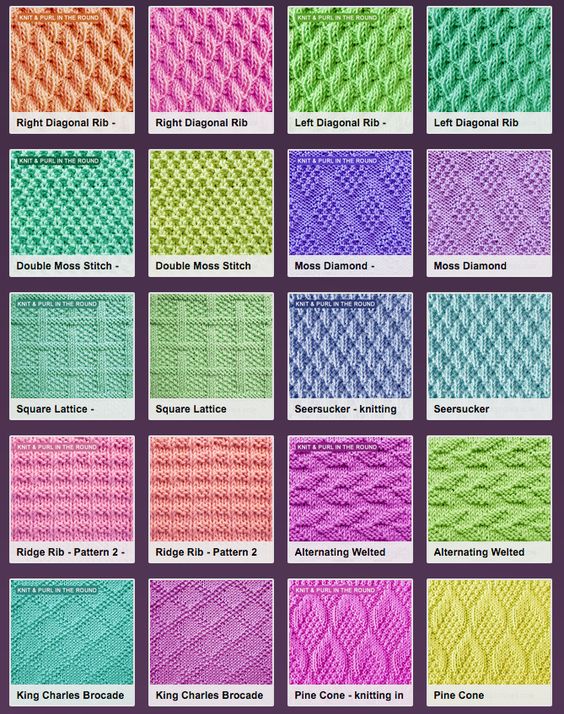Blog
How to Read Knitting Patterns
Learning to read knitting patterns can be a little daunting, especially when they look like they’re written in another language. Take on any pattern with this ultimate guide to understanding knitting patterns.
1. Pick the Right Size
Understand the Size Formatting
Patterns that come in multiple sizes are typically written with the smallest size first and the other sizes in brackets or parentheses like S (M, L, XL). When reading the pattern, wherever the numbers differ between sizes, they will be listed in the same format, and you will keep track of your size based on that.
If a pattern tells you to cast on 10 (12, 14, 16) stitches, and you want to knit the size L, you would cast on 14 stitches because that is the number that corresponds with the size L in the parentheses.

To choose the perfect size and get the best fit, you’ll need to reference the schematic measurements or list of final measurements, which are also frequently formatted in parentheses.
To be sure that you’ve picked the right size, check all of the measurements that correspond to your size and compare them to your own measurements. Knitting patterns have their own standards, and simply picking the size that you’re used to wearing in store-bought clothing won’t always work for you.
Ease and Choosing a Size
When choosing what size to knit, it’s important to understand ease. Ease is the amount of extra fabric that allows for drape and movement. A sweater with zero ease will match your measurements exactly. A sweater with two inches of ease will be slightly looser. A garment has negative ease when it’s smaller than the wearer, and because knits are stretchy, you can comfortably wear sweaters with negative ease for a snugger, more fitted look.
Although ease is most frequently mentioned when referring to garments, it’s also important to understand the amount of ease you prefer in accessories. Headbands and hats fit snugly with negative ease and are unlikely to slip out of place, but hats with positive ease are less likely to crush your hair style.
To get an idea of what amount of ease you like to wear, measure some of your store-bought sweaters and accessories and compare them to your own measurements.

A pattern’s schematic lists the final measurements of the project, and when you’re looking at it to choose your size, you’ll have to keep in mind the amount of ease you prefer, as well as the pattern’s recommendation.
Let’s imagine we have a sweater pattern that includes sizes S (M, L, XL). The schematic lists the finished measurements as 34 (38, 42, 46) inches. If you have a 40 inch bust and you’re trying to choose a size when the pattern recommends 2–3 inches of negative ease, you’d want to knit the size M with a 38 inch bust measurement. If the pattern recommends 2–3 inches of positive ease, you’d want to knit the size L with a 42 inch bust measurement.
Some patterns will include measurements “to fit” when listing the sizes. These measurements have the recommended ease incorporated into them, and you simply need to pick the size with measurements that most closely match your own.
2. Choose the Perfect Yarn and Needles
Weight and Gauge
Yarn comes in a variety of sizes known as weights. The most common names for the sizes from smallest to largest are lace, fingering, sport, DK or double knit, worsted, aran, bulky, and super bulky. Yarns often don’t include their weight on their packaging, and it can take some experience and practice to learn the different weights.
When substituting yarn in a pattern, look at the recommended needle size and gauge in the pattern and compare it to the recommended needle size and gauge on the yarn’s packaging. This will help point you in the right direction for most patterns.
However, designs that feature fine yarn at an extra-loose gauge, or bulkier yarn at an extra-dense gauge can steer you in the wrong direction, so it’s helpful to look up the weights of the recommended yarn and potential substitutes on the manufacturer’s website or Ravelry’s yarn database.

Fiber
Different fibers have different qualities, and it’s important to keep that in mind when you substitute yarn. Choose yarns with similar fibers or with similar qualities. Here are some of the more common fibers you’ll run across:
| Fiber | Qualities | Best For |
| Wool | Elastic, “sticky,” and warm | Fitted garments, winter accessories, and colorwork |
| Cotton | Inelastic, washable, and smooth | Summer tops and household goods |
| Acrylic and Nylon | Elastic, hard-wearing, and washable | Sturdy projects |
| Silk | Drapey and smooth | All-season projects |
| Alpaca | Drapey and warm | Winter accessories |
Swatch
Before you dive into a pattern, you need to knit a swatch to make sure that the needles and yarn you choose will give you the recommended gauge. The entire pattern is calculated based on the recommended gauge, and if you’re knitting with a different number of stitches and rows than what is recommended, your project will end up too big or too small. Being off by just fraction can ruin a larger project because those fractions add up.
For the best results, knit a large swatch and wash and block it. Many yarns bloom or grow when they’re first washed because of the spinning process and/or their fiber content, so it’s important to wash your swatch if you plan on ever washing your project. Once your swatch has dried, measure your gauge over a larger area.
If your gauge is too big, try knitting a new swatch on a smaller needle size. If you gauge is too small, try a larger needle size. To save time, I like to knit two or three swatches with different needles all at once so I can wash and block all of my swatches together.
Although it can be frustrating to go through this process when you’re ready to dive into a new project, it will spare you the grief of knitting a whole sweater only to have it turn out gorilla-sized after you wash it for the first time.Advertisement
3. Understand the Language
Abbreviations
| Abbreviation | Meaning |
| BO | Bind off |
| CBN | Cable needle |
| CC | Contrast color |
| CM | Centimeter |
| CO | Cast on |
| Cont | Continue |
| Dec | Decrease |
| DPN | Double pointed needle |
| FT | Feet |
| G | Gram |
| IN | Inch |
| Inc | Increase |
| K | Knit |
| KFB | Knit front and back; one stitch increase |
| K2Tog | Knit two together; one stitch decrease |
| K3Tog | Knit three together; two stitch decrease |
| KWise | Knitwise |
| LP | Loop |
| M | Meters |
| M1 | Make one; one stitch increase |
| MC | Main Color |
| MM | Millimeter |
| OZ | Ounces |
| P | Purl |
| PM | Place marker |
| P2Tog | Purl two together; one stitch decrease |
| PSSO | Pass slipped stitch over |
| PWise | Purlwise |
| Prev | Previous |
| Rep | Repeat |
| Rev STST | Reverse stockinette stitch |
| RND | Round |
| RS | Right side |
| SL | Slip |
| SM | Slip marker |
| SK2P | Slip one, knit two together, pass slipped stitch over; two stitch decrease |
| SSK | Slip, slip, knit slipped together; one stitch decrease |
| SSP | Slip, slip, purl slipped together; one stitch decrease |
| ST(S) | Stitch(es) |
| STST | Stockinette stitch |
| TBL | Through the back loop |
| Tog | Together |
| WS | Wrong side |
| WYIB | With yarn in back |
| WYIF | With yarn in front |
| YD | Yard |
| YO | Yarn over; one stitch increase |
Commonly Used Phrases
| Phrase | Meaning |
| * ; Rep from * | Repeat the instructions in between the asterix and the semicolon as many times as stated. |
| [ ] X times | Repeat the instructions in the bracket as many times as stated (X). |
| At the same time | Work these instructions at the same time as the previous instructions. This instruction is most frequently used when shaping or colorwork needs to be incorporated at the same time as other instructions. Pay close attention and be sure to read ahead. |
| Continue to work as established | Repeat the general instructions of the previous set of rows. You may see this instruction when you’re working sets of short rows with each row one stitch longer than the last, when you’re working one shaping row and a handful of plain rows a certain number of times, or when you’re simply repeating a stitch pattern. |
| Reverse shaping | This instruction is typically included for pieces with a matched left and right. Work the shaping opposite as before, moving increases or decreases from the left side to the right or vice versus and switching left slanting stitches like SSK with right slanting stitches like K2TOG and right slanting stitches with left slanting stitches. This will create mirrored pieces. |
| Work as for X | Follow the same instructions as for the given piece or section (X). |
| Work even | Work in the given stitches patterns without increasing or decreasing. |
| X to end | Work to the end of the row or round using the stitch or stitch pattern given (X). |
Reading Charts
Whether they’re lace, cables, or colorwork, all charts typically show the right side view of the stitch pattern and have to be used accordingly. Working from the bottom up (like how your stitches appear on your needles), right side rows and all rounds are read from right to left.
Wrong side rows are read from left to right, and the wrong side equivalents of the stitches are used. A blank square is typically used to indicate a knit stitch on the right side and a purl stitch on the wrong side.

The sample chart is as follows when worked flat:
Row 1: P1, k1, yo, k2tog.
Row 2: P3, k1.
Row 3: P1, yo, k2tog, k1.
Row 2: P3, k1.
When worked in the round, it’s read slightly differently:
Round 1: P1, k1, yo, k2tog.
Round 2: P1, k3.
Round 3: P1, yo, k2tog, k1.
Round 2: P1, k3.
Get Knitting
With this guide at your side, and our series of fundamental knitting skills, you’re ready to try a fun pattern. Knit one of the gorgeous patterns on Tuts+, like a flirty cropped sweater, a colorful headband, or a cute cabled beret!

Are you a beginner knitter? Let us know if you have any questions or comments about reading patterns.ư
Cre : https://crafts.tutsplus.com/tutorials/how-to-read-knitting-patterns–craft-16674

